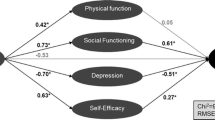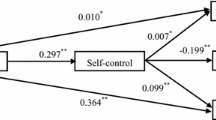Abstract
Physical illness may precipitate psychological distress among older adults. This study examines whether social support and self-efficacy moderate the associations between physical health and depression and anxiety. Predictions were tested in 222 individuals age 60 or older presenting for help with worry. Physical health was assessed through self-report (subjective) and physical diagnoses (objective). Objective physical health did not have a significant association with depression or anxiety. Worse subjective physical health was associated with increased somatic anxiety, but not with depression or worry. The relationship between subjective physical health and depressive symptoms was moderated by self-efficacy and social support. As predicted, when self-efficacy was low, physical health had its strongest negative association with depressive symptoms such that as physical health improved, depressive symptoms also improved. However, the moderation effect was not as expected for social support; at high levels of social support, worse physical health was associated with increased depressive affect.





Similar content being viewed by others
References
Alloy, L. B., Kelly, K. A., Mineka, S., Clements, C. M., Maser, J. D., & Cloninger, C. R. (1990). Comorbidity of anxiety and depressive disorders: A helplessness-hopelessness perspective. In J. D. Maser & C. R. Cloninger (Eds.), Comorbidity of mood and anxiety disorders (pp. 499–543). Washington, DC: American Psychiatric Association.
American Psychiatric Association. (2000). Practice guidelines for the treatment of patients with major depressive disorder (revision). American Journal of Psychiatry, 157, 1–49.
Antony, M. M., Bieling, P. J., Cox, B. J., Enns, M. W., & Swinson, R. P. (1998). Psychometric properties of the 42-item and 21-item versions of the Depression Anxiety Stress Scales in clinical groups and a community sample. Psychological Assessment, 10, 176–181.
Baker, F. M. (1996). An overview of depression in the elderly: A US perspective. Journal of the National Medical Association, 88, 178–184.
Bandura, A. (1977). Self-efficacy: Toward a unifying theory of behavioral change. Psychological Review, 84, 191–215.
Bayliss, E. A., Ellis, J. L., Steiner, J. F., & Main, D. S. (2005). Initial validation of an instrument to identify barriers to self-management for persons with co-morbidities. Chronic Illness, 1, 315–320.
Beck, A. T., Steer, R. A., & Brown, G. K. (1996). Manual for the Beck Depression Inventory-II. San Antonio, TX: Psychological Corporation.
Beekman, A. T. F., de Beurs, E., van Balkom, A. J. L. M., Deeg, D. J. H., van Dyck, R., & van Tilburg, W. (2000). Anxiety and depression in later life: Co-occurrence and communality of risk factors. American Journal of Psychiatry, 157, 89–95.
Ben-Zur, H. (2002). Monitoring/blunting and social support: Associations with coping and affect. International Journal of Stress Management, 9, 357–373.
Blazer, D. G. (2002). Self-efficacy and depression in late life: A primary prevention proposal. Aging and Mental Health, 6, 315–324.
Blazer, D. G. (2003). Depression in late life: Review and commentary. Journals of Gerontology: Series A: Biological Sciences and Medical Sciences, 58, 249–265.
Bosma, H., Sanderman, R., Scaf-Klomp, W., Van Eijk, J. T. M., Ormel, J., & Kempen, G. I. J. M. (2004). Demographic, health-related and psychosocial predictors of changes in depressive symptoms and anxiety in late middle-aged and older persons with fall-related injuries. Psychology and Health, 19, 103–115.
Bourland, S. L., Stanley, M. A., Snyder, A. G., Novy, D. M., Beck, J. G., Averill, P. M., et al. (2000). Quality of life in older adults with generalized anxiety disorder. Aging and Mental Health, 4, 315–323.
Brown, T. A., Chorpita, B. F., Korotitsch, W., & Barlow, D. H. (1997). Psychometric properties of the Depression Anxiety Stress Scales (DASS) in clinical samples. Behaviour Research and Therapy, 35, 79–89.
Bryant, C., Jackson, H., & Ames, D. (2008). The prevalence of anxiety in older adults: Methodological issues and a review of the literature. Journal of Affective Disorders, 109, 233–250.
Cassidy, T., & Burnside, E. (1996). Cognitive appraisal, vulnerability and coping: An integrative analysis of appraisal and coping mechanisms. Counselling Psychology Quarterly, 9, 261–279.
Charlson, M. E., Pompei, P., Ales, K. L., & MacKenzie, C. R. (1987). A new method of classifying prognostic comorbidity in longitudinal studies: Development and validation. Journal of Chronic Diseases, 40, 373–383.
Chou, K. L., & Chi, I. (2001). Social comparison in Chinese older adults. Aging and Mental Health, 5, 242–252.
Davis-Berman, J. (1990). Physical self-efficacy, perceived physical status, and depressive symptomatology in older adults. Journal of Psychology: Interdisciplinary and Applied, 124, 207–215.
De Beurs, E., Beekman, A. T. F., Deeg, D. J. H., Dyck, R. V., & Tilburg, W. V. (2000). Predictors of change in anxiety symptoms of older persons: Results from the Longitudinal Aging Study Amsterdam. Psychological Medicine, 30, 515–527.
Deyo, R. A., Cherkin, D. C., & Ciol, M. A. (1992). Adapting a clinical comorbidity index for use with ICD-9-CM administrative databases. Journal of Clinical Epidemiology, 45, 613–619.
Folstein, M. F., Folstein, S. E., & McHugh, P. R. (1975). Mini-mental state: A practical method for grading the cognitive state of patients for the clinician. Journal of Psychiatric Research, 12, 189–198.
Friedman, M. M. (1993). Social support sources and psychological well-being in older women with heart disease. Research in Nursing and Health, 16, 405–413.
Grant, I., Patterson, T. L., & Yager, J. (1988). Social supports in relation to physical health and symptoms of depression in the elderly. American Journal of Psychiatry, 145, 1254–1258.
Horowitz, A., Reinhardt, J. P., Boerner, K., & Travis, L. A. (2003). The influence of health, social support quality and rehabilitation on depression among disabled elders. Aging and Mental Health, 7, 342–350.
Isaacowitz, D. M. (2005). Correlates of well-being in adulthood and old age: A tale of two optimisms. Journal of Research in Personality, 39, 224–244.
Jang, Y., Haley, W. E., Small, B. J., & Mortimer, J. A. (2002). The role of mastery and social resources in the associations between disability and depression in later life. Gerontologist, 42, 807–813.
Katona, C. L. E. (1991). Psychiatry of old age: Depression in old age. Reviews in Clinical Gerontology, 1, 371–384.
Kim, H. F. S., Braun, U., & Kunik, M. E. (2001). Anxiety and depression in medically ill older adults. Journal of Clinical Geropsychology, 7, 117–130.
Lazarus, R. S., & Folkman, S. (1984). Stress, appraisal, and coping. New York: Springer Publishing Company.
Lenze, E. J., Rogers, J. C., Martire, L. M., Mulsant, B. H., Rollman, B. L., Dew, M. A., et al. (2001). The association of late-life depression and anxiety with physical disability: A review of the literature and prospectus for future research. American Journal of Geriatric Psychiatry, 9, 113–135.
Lewinsohn, P. M., Hoberman, H., Teri, L., & Hautzinger, M. (1985). An integrative theory of depression. In S. Reiss & R. R. Bootzin (Eds.), Theoretical issues in behavior therapy (pp. 331–359). San Diego, CA: Academic Press.
Lindesay, J. (1990). The Guy’s/Age Concern Survey: Physical health and psychiatric disorder in an urban elderly community. International Journal of Geriatric Psychiatry, 5, 171–178.
Lovibond, P. F., & Lovibond, S. H. (1995). The structure of negative emotional states: Comparison of the Depression Anxiety Stress Scales (DASS) with the Beck Depression and Anxiety Inventories. Behaviour Research and Therapy, 33, 335–343.
Majercsik, E., & Haller, J. (2004). Interactions between anxiety, social support, health status and buspirone efficacy in elderly patients. Progress in Neuro-Psychopharmacology and Biological Psychiatry, 28, 1161–1169.
Meyer, T. J., Miller, M. L., Metzger, R. L., & Borkovec, T. D. (1990). Development and validation of the Penn State Worry Questionnaire. Behaviour Research and Therapy, 28, 487–495.
Mollenkopf, H., Marcellini, F., Ruoppila, I., Flaschenträger, P., Gagliardi, C., & Spazzafumo, L. (1997). Outdoor mobility and social relationships of elderly people. Archives of Gerontology and Geriatrics, 24, 295–310.
National Institutes of Health. (1991). Diagnosis and treatment of depression in late life. NIH Consensus Statement, 9, pp. 1–27.
Oxman, T. E., Freeman, D. H., Manheimer, E. D., & Stukel, T. (1994). Social support and depression after cardiac surgery in elderly patients. American Journal of Geriatric Psychiatry, 2, 309–323.
Parashos, I. A., Stamouli, S., Rogakou, E., Theodotou, R., Nikas, I., & Mougias, A. (2002). Recognition of depressive symptoms in the elderly: What can help the patient and the doctor. Depression and Anxiety, 15, 111–116.
Sallis, J. F., & Lichstein, K. L. (1982). Analysis and management of geriatric anxiety. International Journal of Aging and Human Development, 15, 197–211.
Schneeweiss, S., Wang, P. S., Avorn, J., Maclure, M., Levin, R., & Glynn, R. J. (2004). Consistency of performance ranking of comorbidity adjustment scores in Canadian and U.S. utilization data. Journal of General Internal Medicine, 19, 444–450.
Senior, A. C., Kunik, M. E., Rhoades, H. M., Novy, D. M., Wilson, N. L., & Stanley, M. A. (2007). Utility of telephone assessments in an older adult population. Psychology and Aging, 22, 392–397.
Sherer, M. (1982). The Self-efficacy Scale: Construction and validation. Psychological Reports, 51, 663–671.
Sherman, A. M., Shumaker, S. A., Rejeski, W. J., Morgan, T., Applegate, W. B., & Ettinger, W. (2006). Social support, social integration, and health-related quality of life over time: Results from the Fitness and Arthritis in Seniors Trial (FAST). Psychology and Health, 21, 463–480.
Smalbrugge, M., Pot, A. M., Jongenelis, K., Beekman, A. T. F., & Eefsting, J. A. (2005). Prevalence and correlates of anxiety among nursing home patients. Journal of Affective Disorders, 88, 145–153.
Southern, D. A., Quan, H., & Ghali, W. A. (2004). Comparison of the Elixhauser and Charlson/Deyo methods of comorbidity measurement in administrative data. Medical Care, 42, 355–360.
Spitzer, R. L., Williams, J. B., Gibbon, M., & First, M. B. (1992). The Structured Clinical Interview for DSM-III-R (SCID): I. History, rationale, and description. Archives of General Psychiatry, 49, 624–629.
Stanley, M. A., Novy, D. M., Bourland, S. L., Beck, J. G., & Averill, P. M. (2001). Assessing older adults with generalized anxiety: A replication and extension. Behaviour Research and Therapy, 39, 221–235.
Tabachnick, B. G., & Fidell, L. S. (2001). Using multivariate statistics (4th ed., p. 151). Boston, MA: Allyn and Bacon.
Takaki, J., Nishi, T., Shimoyama, H., Inada, T., Matsuyama, N., Kumano, H., et al. (2003). Interactions among a stressor, self-efficacy, coping with stress, depression, and anxiety in maintenance hemodialysis patients. Behavioral Medicine, 29, 107–112.
Wallace, J., & O’Hara, M. W. (1992). Increases in depressive symptomatology in the rural elderly: Results from a cross-sectional and longitudinal study. Journal of Abnormal Psychology, 101, 398–404.
Ware, J., Jr., Kosinski, M., & Keller, S. D. (1996). A 12-Item Short-Form Health Survey: Construction of scales and preliminary tests of reliability and validity. Medical Care, 34, 220–233.
Welch, D. C., & West, R. L. (1995). Self-efficacy and mastery: Its application to issues of environmental control, cognition, and aging. Developmental Review, 15, 150–171.
Williamson, G. M., Shaffer, D. R., & Parmelee, P. A. (2000). Physical illness and depression in older adults: A handbook of theory, research, and practice. Dordrecht, Netherlands: Kluwer Academic Publishers.
Yochim, B. P., Kerkar, S. P., & Lichtenberg, P. A. (2006). Cerebrovascular risk factors, activity limitations, and depressed mood in African American older adults. Psychology and Aging, 21, 186–189.
Zimet, G. D., Dahlem, N. W., Zimet, S. G., & Farley, G. K. (1988). The Multidimensional Scale of Perceived Social Support. Journal of Personality Assessment, 52, 30–41.
Acknowledgments
While conducting this research, Amber Paukert received support as a graduate student at the University of Houston, a psychology intern at Baylor College of Medicine, and a postdoctoral research fellow (TPP 61-000) for the Department of Veterans Affairs, Veterans Health administration, Health Services Research and Development Service (HSR&D) in Seattle, WA. This work was also supported in part by the Houston VA HSR&D Center of Excellence (HFP90-020), the Veterans Affairs South Central Mental Illness Research, Education and Clinical Center, and a grant from the National Institute of Mental Health (NIMH) (R01-MH53932) for $1,826,539 from 2003 to 2008 to the last author.
Author information
Authors and Affiliations
Corresponding author
Additional information
The views expressed in this article are those of the authors and do not necessarily reflect the position or policy of the Department of Veterans Affairs.
Rights and permissions
About this article
Cite this article
Paukert, A.L., Pettit, J.W., Kunik, M.E. et al. The Roles of Social Support and Self-Efficacy in Physical Health’s Impact on Depressive and Anxiety Symptoms in Older Adults. J Clin Psychol Med Settings 17, 387–400 (2010). https://doi.org/10.1007/s10880-010-9211-6
Published:
Issue Date:
DOI: https://doi.org/10.1007/s10880-010-9211-6




